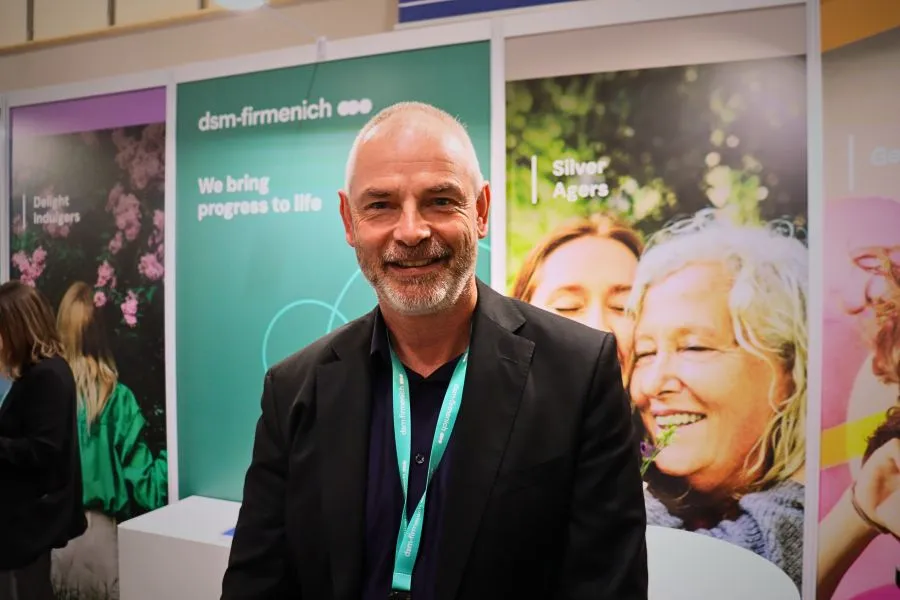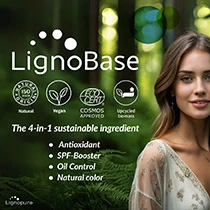SEPAWA Congress 2025 live: dsm-firmenich’s senolytic tech to future-proof skin and hair
Key takeaways
- dsm-firmenich presents senolytic innovations at SEPAWA 2025 that proactively strengthen skin before aging begins.
- Its Eterwell Youth and Syn-Coll CB combination nearly doubled collagen benefits in clinical studies.
- The company promotes a “get-ahead” approach to healthy aging, focusing on prevention and optimization rather than reversal.

dsm-firmenich is presenting a series of longevity-inspired innovations targeting cellular aging mechanisms at the ongoing SEPAWA Congress 2025 in Berlin, Germany. The company is diving into the science of cellular senescence and senolytic technologies designed for skin care and hair care.
Personal Care Insights speaks with Matthias Gempeler, senior principal scientist at dsm-firmenich, live on the show floor. He tells us how the company’s latest actives approach healthy aging through molecular research.
“We are showcasing some of our recent innovations, and it’s a lot about the term longevity, which is trendy,” says Gempeler. “Within this space, we focus on specific hallmarks of aging, one of which is senescence. On the topic of senescence, we recently launched two senolytic molecules. One is for skin care, and the other for hair care.”
Gempeler explains that the company’s Syn-Coll CB skin care molecule has already been in the market for some time and has seen strong acceptance, which he attributes to its research.
“We really tried to make a deep dive into senescence,” he notes. “This means we start at a gene level and screen different products. We have an assay in place where we really can show the effect on senescent cells.”
The company advanced this work into clinical studies, where the active ingredient was shown to outperform traditional anti-aging solutions in controlled trials.
“If you do things in this big space of longevity, you need to have solid technology behind it, and this is what we did.”
Senolytics from skin to scalp
Senolytic technology targets cell senescence, where aged or “sleepy” cells, often nicknamed “zombie skin cells,” have stopped dividing but do not die off like they should. Gempeler shares that dsm-firmenich’s senolytic technology has moved beyond skin, extending to hair and scalp health.
He explains that the team adapted their fibroblast assays to hair cells to confirm measurable benefits in placebo-controlled, double-blind studies.
.webp) dsm-firmenich’s senolytic technology has moved beyond skin, extending to hair and scalp health.“We screened a lot of plant molecules, especially looking into plant flavonoids and biotech flavonoids. The second step was when we were able to transfer this assay with the senescent fibroblasts into hair, into papilla cells, where we were also able to show an effect on hair, such as hair density, for example.”
dsm-firmenich’s senolytic technology has moved beyond skin, extending to hair and scalp health.“We screened a lot of plant molecules, especially looking into plant flavonoids and biotech flavonoids. The second step was when we were able to transfer this assay with the senescent fibroblasts into hair, into papilla cells, where we were also able to show an effect on hair, such as hair density, for example.”
The next phase focused on combining senolytic actives with established anti-aging ingredients for combined benefits.
“One of our hypotheses was from the beginning: if you combine a senolytic with a traditional anti-aging molecule, retinol, for example, you will increase the effect of the traditional treatment,” says Gempeler.
“As you make the cell population healthier by removing the senescent cells, the remaining cells have a clear advantage, and they start to produce even better, work even better than in the past.”
The company’s clinical study in China confirmed this synergy. “We were able to show that if we combine one of our peptides — in this case, it was a tripeptide, Syn-Coll CB — with the current Eterwell Youth senolytic technology, we were able to show that the combination of these two molecules nearly doubles the effect on specific endpoints such as collagen, but also had a positive effect on pore size.”
According to Gempeler, the finding opens up formulation flexibility. If a company is cost-cautious, the senolytic molecule allows formulators to use a lower concentration of an anti-aging ingredient, and still have the same efficacy.
However, suppose a company wishes to formulate a product with maximum efficacy. In that case, he says: “You keep the concentration [of the anti-aging ingredient] as is, but you add this senolytic molecule so you would gain a better activity at the end.”
Prevention to optimization
While anti-aging research traditionally targets mature consumers, dsm-firmenich is extending its focus to include younger generations.
“Recently, we also started to look, first of all, into ethnicities, so testing product differences in all different ethnicities, but also on different ages,” says Gempeler.
.webp) The senolytic molecule allows formulators to use a lower concentration of an anti-aging ingredient.“For example, the question was always, if you move a bit away from traditional anti-aging more to healthy aging, how can you also propose such a system to younger generations?”
The senolytic molecule allows formulators to use a lower concentration of an anti-aging ingredient.“For example, the question was always, if you move a bit away from traditional anti-aging more to healthy aging, how can you also propose such a system to younger generations?”
The company’s peptide study involved participants in their 30s, middle-aged groups, and those around 60. “We were able to show the effect on each of these generations,” he shares.
“‘Longevity’ allows you to make completely different claims. It is not about living longer because of cosmetics, this is obvious — but maybe we’re living better, feeling more confident.”
He adds that this confidence-building effect starts young. “Look at people in their 20s. Why should they use an anti-aging treatment, because they are not old? As we know, collagen might start to decrease at the age of 30, and then it will go down.”
The scientist argues for a preventive and optimizing approach: “If you do such a treatment at the early stage, you preserve, prolong, or even improve your collagen situation in the early years. This means once the aging process starts, you start from a much higher level than before. It’s a kind of prevention optimization.”













